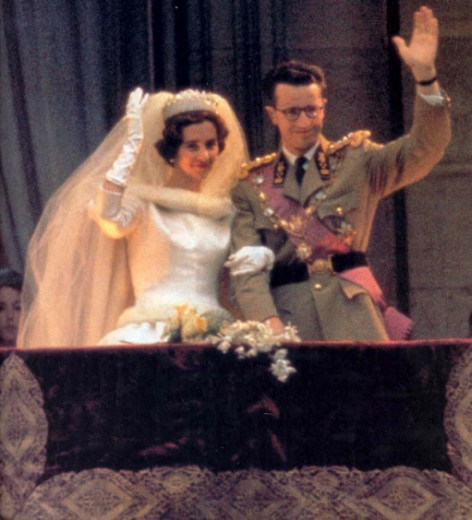

In the Collegial, the three thousand guests had begun arriving. White flowers took the main part of the decoration inside the church, while outside a red canopy covered the staircase of the Great West Door. Flowers lined the canopy up the stairs and so did soldiers from the three services, who also lined part of the nave and its long red carpet, which led from the Great West Door to the Quire and the golden altar. Above it, the coat of arms of the Kingdom formed part of the ornamentation, as did the big banners from the various Belgian provinces, hanging from the high walls, though the nave.
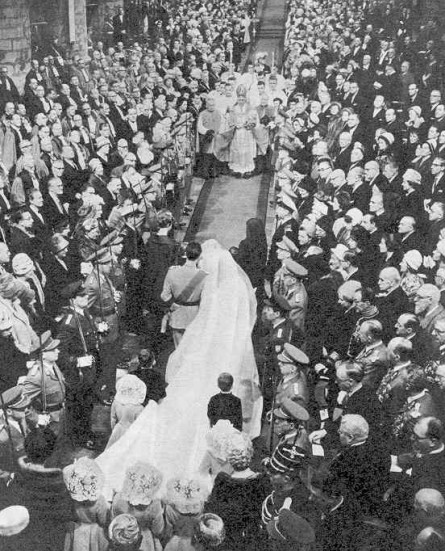
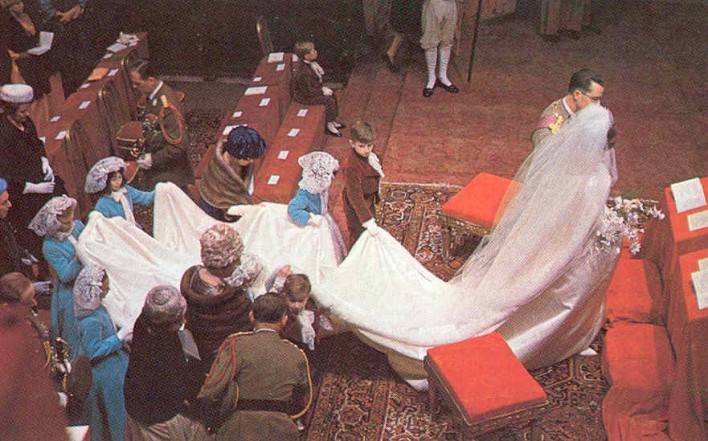
Meanwhile, at the Collegial, the the representatives of the Royal Houses of Europe had begun receiving the cheers of the people gathered in the enormous square in front of the church. Only those closely attached to the royal couple, the closest family, followed behind the Cadillac. Soon the cortege approached the Collegial and everyone prepared for the first public sight of the magnificent dress of Queen Fabiola, who was given a loud cheer as she left the car. The King promptly helped her to leave and to mount the staircase, while King Leopold and the Marchioness of Casa Riera left their car and followed the couple up the stairs. Queen Fabiola’s brother, the Marquis of Casa Riera, escorted Queen Elizabeth of the Belgians, who was immensely cheered by her loving people. The Count of Barcelona (barred from appearing in the Spanish press by Franco regime and missing in each picture of the issue of ¡Hola! magazine which covered the event) accompanied HRH Princess Liliane and other members of the family, including the couple’s siblings, followed in the cortege.
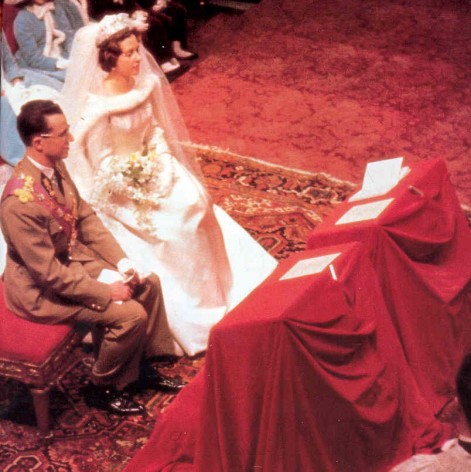
Looking rather serious, King Baudouin and Queen Fabiola went up the aisle into the Quire and stopped in front of the altar, near the two kneelers covered in red, in front of which sat His Eminence the Cardinal Van Roey, Archbishop of Brussels-Malines. The old Cardinal had married, back in 1926, the then Prince Leopold and Princess Astrid of Sweden in that same Collegial Church. The previous year, in 1959, he had married the Prince of Liège and now it was the first time in history that a King of the Belgians was getting married in Belgian soil, and it was to Cardinal Van Roey a special honour and a tremendously moving moment. He was, actually, marrying a King for the second time, since he had officiated, during the dark years of World War II, the wedding of King Leopold and Miss Liliane Baels, to whom was given the titles of Royal Highness, Princess of Belgium and Princess of Réthy.
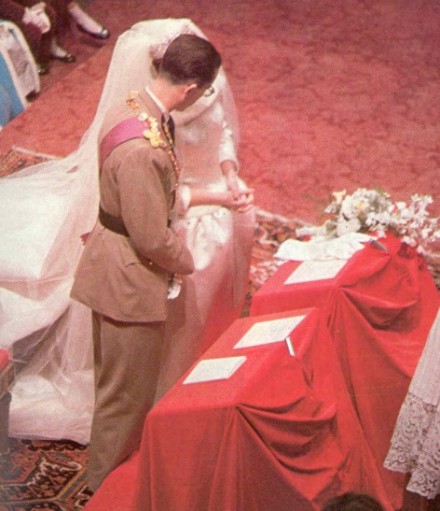
Immediately after, the Cardinal delivered his speech, before asking the royal couple to rise and rising himself. He then asked the King to repeat his words and with that came the most moving moment of the ceremony, with the King changing the “vous” for the “toi”. The Cardinal asked the King to say “Moi, Baudouin, je vous donne à vous, Fabiola, que je tiens ici par la main, ma foi de mariage, et je vous prends pour ma légitime épouse, devant Dieu et la Sainte Église.” However, the King and, after him, the Queen, giving a much more personal tone to the words they were pronouncing, said instead:
“Moi, Baudouin, je te donne à toi, Fabiola, que je tiens ici par la main, ma foi de mariage, et je te prends pour ma légitime épouse, devant Dieu et sa Sainte Église.”
“Moi, Fabiola, je te donne à toi, Baudouin, que je tiens ici par la main, ma foi de mariage, et je te prends pour mon légitime époux, devant Dieu et la Sainte Église.”
The Cardinal then pronounced the blessing and confirmation of the wedding in Latin, and then blessed the wedding rings, which were brought in a silver plate. Again the couple, while exchanging the rings, changed the “recevez” for “reçoit”. The Cardinal and the other clerics who were around him then left the Altar, since it was the Auxiliary Bishop, Monsignor Suenens, that would officiate the Mass, clothed in the Charles V chasuble, with magnificent gold embroidery. While this was happening, at the end of Quire a choir of children sang graciously. During the Mass, through the readings and the consecration, the King and the Queen of the Belgians stood kneeled, notably showing that in that moment they were no more than two Christians in the most special moment of their lives.
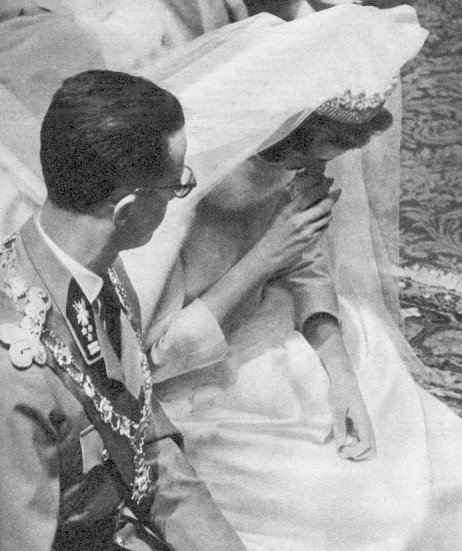
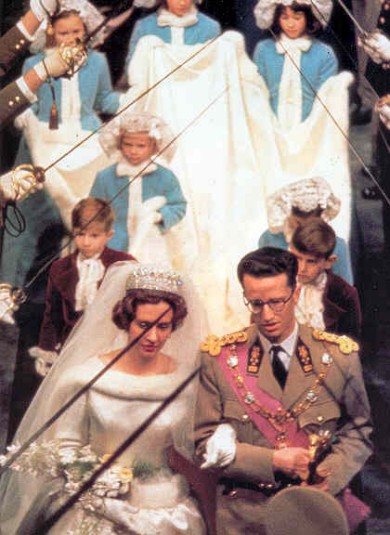
After stepping down the staircase, Queen Fabiola spontaneously handed her bouquet of white orchids and orange-tree white flowers to King Baudouin, and waved and thanked with both hands, for all those cheers, all that love she was receiving. Meanwhile, canon blasts were heard and the bells of all the churches of the Kingdom were sounded in honour of the new Queen. The cortege then restarted, towards the Palace, but now through a much longer route, which included the world-famous Grand Place and allowed many hundreds of thousands to cheer their new Queen. “Vive la Reine” was the most heard cheer and it was heard much higher when the Cadillac arrived at the Palace Square and the Brabançonne, the National Anthem was played.
Inside, the King would offer a banquet to two thousand guests, in the Throne Room and the adjacent rooms and everything was fervently being prepared. But while the cortege was still entering the Palace gates outside, the people were already crying for what would be the climax of the day, the appearance on the balcony of the imposing Royal Palace. An officer of the royal court came out to the balcony to put a velvet and gold cloth and soon afterwards the King and Queen of the Belgians came outside to be truly acclaimed by thousands and thousands who forced the security barriers. Queen Fabiola thanked again, with both her hands. It had been the most extraordinary day and she would, later, in perfect French and Flemish, thank the whole country in a surprise television and radio address with the King in which Her Majesty said that “from now on, my heart and my life belong no only to my husband but to you all”. The King, quoting Saint-Exupéry, said that “to love is not looking at each other, it is looking together in the same direction”.
